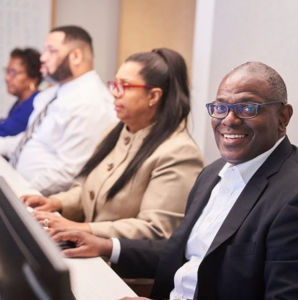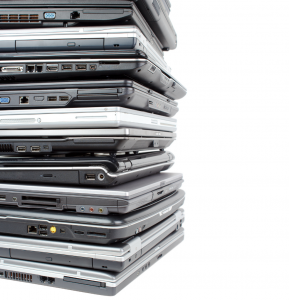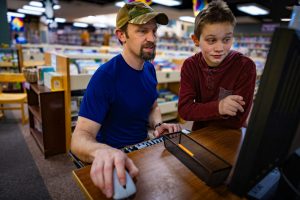 The COVID-19 crisis exposed a deep, persistent “technology gap,” as millions of people were cut off from school, employment, telehealth, and community. The lack of access to devices, internet, and technical support, and digital skills has existed as long as computers have, but there has never been a more pressing moment to address these issues.
The COVID-19 crisis exposed a deep, persistent “technology gap,” as millions of people were cut off from school, employment, telehealth, and community. The lack of access to devices, internet, and technical support, and digital skills has existed as long as computers have, but there has never been a more pressing moment to address these issues.
The technology gap can be broken down into three main issues:
No-Computer Households
According to a recent Pew Research Study, 43% of low-income households, an estimated 15.2 million people, are without a desktop or a laptop computer in the United States alone. This puts these families (both adults and children) at a disadvantage when considering education, career-building, communication, and basic life needs in the modern world.
Under-Deviced Households
One computer is not enough for today’s families. Consider a family of four. If the parents are looking for jobs or seeking to further their education, they both need a computer. Or one parent may need access to a computer for a telehealth appointment while another needs it for work.
As schools make more use of technology than ever, including for virtual learning, each child may need access to a computer at the same time. If these families all must share one device, they will find themselves challenged at school, at work, and more.
Digital Literacy
Providing devices is only part of the solution, as 32 million people in America cannot use a computer effectively. For those looking to increase their career opportunities, computer skills are essential. A recent study by Burning Glass, a tech company that conducts research on the labor sector, found that 82% of “middle-skill jobs” require computer literacy.
Middle-skills jobs that are considered “digitally intensive” often pay upwards of $28 an hour, well above minimum wage. These jobs provide opportunities for development and upward movement to high-skill and higher paying jobs. Yet, half of adults in the United States aren’t comfortable using technology to learn.
That’s the Problem. So, What’s the Solution?
There is no shortage of computers that can be donated to those who need one. According to Statista, 56.2 million computers were sold in 2019 alone. Businesses and individuals typically upgrade or replace their computers every two to three years to stay current with ongoing advances in hardware and software. But where are all those retired computers now?
The two most common ways people dispose of used technology are:
Recycling
Most local trash disposal companies take your computer at no cost. After they receive the computer, they disassemble it and recycle some parts. Precious metals like gold, silver, platinum, and palladium are removed for their value. Some recyclers may give you a small credit for the value of those metals, which would be considered your Return on Investment (ROI).
Resale
Many Information Technology Asset Disposition (ITAD) companies, both online and brick and mortar, offer to buy your old machines at a fraction of the cost of what you paid for them. These for-profit ITAD providers wipe your data, repair broken machines, refurbish the computers, and resell them to a third party. Your ROI here is most often calculated as a small percentage of the third party sale.
A Better Option

For many years, Digitunity has proudly supported the nation’s nonprofit refurbishers by sourcing and placing donated computers with them, providing project and funding opportunities, fostering relationships, amplifying their work, and advocating for technology reuse and changes to policies and practices that lead to a greater supply of devices for the entire field.
Refurbishers safely and securely process thousands of donated corporate computers monthly while adhering to the same operational and data security standards as for-profit ITAD organizations.
The difference is that these nonprofit refurbishers focus on refurbishing these computers, often bundling them with software, wi-fi hotspots, and training, and providing them to low-income families and other small nonprofits at low or no cost to the technology recipient.
ROI + ROC
When disposing of your old tech by traditional means, your potential Return on Investment (ROI) is limited. CSImarket.com estimates the average ROI on tech equipment to be around 11%. But what about your Return on Community (ROC)? How are your used computers making a lasting impact in your own neighborhood?
When thinking about the value of a retired computer, we don’t just measure the simple monetary return (ROI) of that investment. At Digitunity, we calculate the total value of that refurbished computer using a much different valuation, what we call Return on Community (ROC). Return on Community measures how much impact your donation has on people and the environment.
Just one computer can:
- Give a student access to education and turn it into a job that takes their family out of generational poverty.
- Help an unemployed person pursue a new business or career path.
- Ensure an older adult is less lonely and isolated.
- Provide access to telehealth.
- Allow a refugee to learn essential workplace skills to support their family.
- Change the life of a veteran by interrupting the cycle of homelessness and poverty through digital education, training, and resources.
- Give a person with disabilities the chance to make an income without being limited to physical labor.
When you donate your used computers through one of our nonprofit refurbishers, your ROC is far-reaching. You make a difference in people’s lives by opening opportunities to education, jobs, and connection. Every day, we hear stories from the field illustrating the real-world value of Return on Community.
Here is what one recipient shared with us recently:
“I’m a student at a local college. Thanks to this donation, I have been able to concentrate more on my studies. I have a very limited income, so every expense is stressful. Thanks to this low-cost internet and the free Chromebook provided by your organization, I have been able to experience some relief of the stress that I experience monthly. Most everything related to school has ties to the internet or a computer, so in order to succeed you must have access to both.”
When you donate your used computers, you change the lives of people.
Take the First Step
Your company’s ROC is just one computer away. Click here to fill out our donation information form. We will match you with a worthy organization in your area, so you can start changing lives today.
Learn More
If you’d like to learn more about how donating your computers can help to close the technology gap, check out our infographic to the right. If you’d like a larger copy sent to you, you can fill out our form here. We’ll email you the infographic along with more information about the technology gap and other ways you can get involved.



